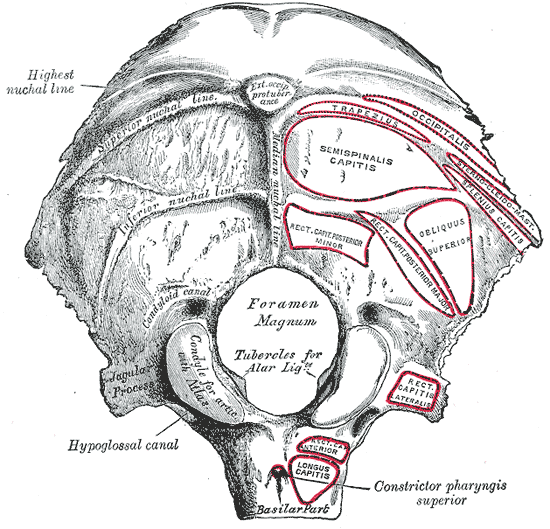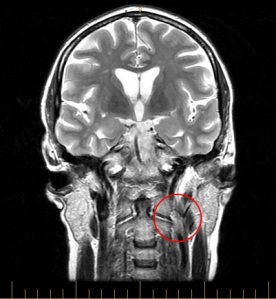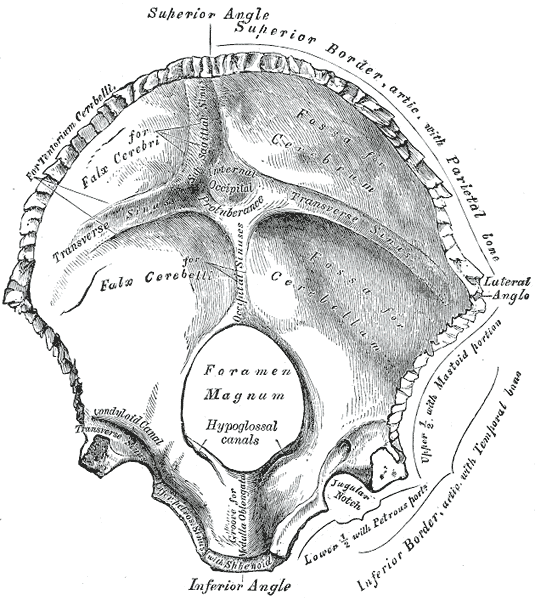The term CCSVI (chronic cerebrospinal venous insufficiency) implies there is insufficient capacity in the venous drainage system to sufficiently drain the brain. The source of CCSVI is currently attributed to stenosis in distant jugular and thoracic veins that cause backups in the brain. While I believe that many cases are, in fact, caused by an insufficiency in drainage capacity, I don’t believe the vast majority of these cases are due to stenosis in jugular and thoracic veins.
Instead, I believe the insufficiency in most cases lies in less than perfect drainage designs of the brain inside the skull. The case on the left is supposedly caused by stenosis of the left internal jugular vein in front of the first and second cervical vertebral of the upper cervical spine. The problem is that many people are simply born with variations in design such as significantly smaller size in one of the transverse sinus to sigmoid sinus to internal jugular vein routes inside the skull. You can see the major drainage routes of the brain in the previous post. As an aside, the white you see in the scan are the spaces and chambers of the brain filled with water for cushioning and protection. The large chambers in the middle of the brain are where the water is produced.
It doesn’t matter though whether it is due to stenosis in the jugular and thoracic veins or a case of inherent insufficiency due to design problems. The good news is that in either case, regardless of where the insufficiency is found, the liberation procedure most likely works by acting like a siphon to assist in draining the backup in the brain. But knowing the precise location of the insufficiency could influence the decision as to where to do the angioplasty or to place the stents to be the most effective in future operations.
In this regard, I believe that the vast majority of cases of venous drainage problems in the brain, however, are not caused by insufficient drainage capacity. In contrast to insufficiency, I believe, most cases of venous drainage problems in the brain are due to chronic craniocervical venous back pressure or CCVBP, which is acquired through trauma, aging and degenerative conditions of the cervical spine. There is plenty of physical anthropological forensic evidence to support my theory which can be seen in normal, pathological and artificially deformed skulls. Further anthropological studies should be done. I discuss the topic thoroughly in my book in the chapter called “Acute Versus Chronic Back Pressure.” There are several scenarios that can cause CCVBP.
The brainstem passes through the foramen magnum in the base of the skull. The base of the skull in humans is bent, which puts the foramen magnum directy beneath a large portion of the mass of the brain and brainstem. This puts the brainstem in a precarious position in humans, perched above the foramen magnum below it, and beneath a large portion of the mass of the brain above which bears down on it. In this regard, a significant portion of the drainage system of the brain is found on the base of the skull near and in the foramen magnum making it especially susceptible to compression.
The Cisterns, Brain Flotation and Chiari
To keep it in its proper position the brainstem floats in a water jacket. The water around the brainstem and cerebellum near the base of the brain is contained in several large collapsible wells called cisterns. Because of the way this particular brain scan was done, in contrast to the preceding image, the cisterns are the shadows surrounding the brainstem and cerebellum and are filled with water. It’s the complete opposite of the other image where the water is white. As in the preceding image, the shadows in the middle of the brain and in the cerebellum are the chambers of the brain called ventricles. The ventricles are connected to the cisterns, but that’s another topic.
The cisterns are large dilations in the middle space of the protective coverings of the brain called the meninges. The space inside the protective coverings is called the subarachnoid space. The cisterns are part of the subarachnoid spaces that contain cerebrospinal fluid (CSF) and surround and protect the brainstem and cerebellum from banging into the hard bones of the base of the skull. More importantly, they protect the brainstem and cerebellum from sinking into the foramen magnum. This sinking is referred to as a pressure conus or Chiari malformation.
The shadow you see beneath the frontal lobe is the notch in the base of the skull for the pituitary gland. The crossing of the optic nerves lies just above the notch. Additionally, there is another important cistern that lies beneath the frontal lobe of the brain. It’s job is to protect the optic nerves from compression by the forebrain against the front of the base of the skull. Compression of the optic nerve is most likely one of the primary causes of optic neurtitis, which I will discuss further in future posts.
Getting back to the brainstem, a Chiari malformation can cause catastrophic consequences. Among other things, besides compressing the cord and potentially depressing all vital functions in the body, it can also block both venous blood and cerebrospinal fluid pathways that pass through the foramen magnum and into the spinal cord at this point.
The Occiput and Drainage Routes
Let’s forget about CSF for now and just focus on the venous outlets as they pertain to CCSVI. The sketches below are of the occipital bone which forms a large portion of the rear part of the base of the skull. It is also contains the attachment points for the upper cervical spine to the skull.
The sketch below is of the inside of the occipital bone. The view is from above looking down into the base of the skull. The transverse sinus, the internal occipital protuberance and occipital sinus inside the occipital bone are like dry river beds. The dural sinus veins of the brain channeled these courses into the bone just like a river cuts through earth and rock. The transverse sinus drainage routes head for the jugular veins. You can see the jugular notch which forms part of the jugular foramen.
Lower down, the occipital sinus system in the middle flows into the lowest drainage veins in the brain, which I call the basement veins. The best basement veins used by humans tend to be located in or near the foramen magnum. Two important outlets often used are the hypoglossal and condyloid canals. You can see the condyloid canal on the left. Notice how close it is to the jugular outlet.
In addition to the vertebral vein connections, these outlets also contain important cranial nerves. One particular cranial nerve is called the hypoglossal nerve that goes to the tongue. Another cranial nerve is called the vagus nerve. Vagus means a wanderer like a vagabond. It called the wanderer because it wanders out from the brainstem to every organ in the chest and abdominal cavities and plays an important role in their function and regulation. Rubbing the carotid sinuses on either side of the Adam’s apple for example will cause a vasovagal response that lowers blood pressure.
Chiari Conditions, CCSVI and Nerve Compression
Chiari conditions can compress these and other cranial nerves just like the optic nerve mentioned above. Among other things, compression of the hypoglossal nerve can cause slurred speach. Compression of the vagus nerve can cause nausea, vomiting and feelings of fainting. Higher up in the cranial vault, compression of the optic nerve causes pain and blindness. Among other things, nerves do not like compression. Picture hitting your not so “funny” elbow bone and recall what that feels like. It’s like pressing on your eyeball or pinching your skin. It hurts. Nerves are meant to be highly sensitive. It’s there job to be sensitive. That’s why the brain is surrounded by water to protect it from compression against the hard walls of the cranial vault, as well as from itself.
The hypoglossal and condyloid canals exit the skull near the condyles on the bottom of the base of the skull. The condyles are large kidney shaped knuckle type joints that link the skull to the first cervical vertebra called atlas or C1.

The Upper Cervial Connection to Chiari and CCSVI
The ridges and circles you see on the sketch are for the attachment of the neck and special upper cervical muscles. I will be discussing misalignments of the upper cervical spine so it is important to understand the relationship of the atlas vertebra in the upper cervical spine to the jugular foramen and the hypoglossal and condyloid canal outlets. As you can see in the sketches above, they are all located close to the atlas vertebra. The transverse processes of atlas extends out toward the jugular notch. Because of this close arrangement it only takes microplastic, miniscule misalignment type strains to cause compression of the soft tissues surrounding the openings in the base of the skull and subsequent back pressure against their veins that can have a major impact on fluid mechanics in the brain.
Back pressure against the veins of the brain near the base of the skull can cause venous congestion called edema inside the brain. It can also decrease the passive CSF production pressure gradient used during upright posture for brain support. This would cause a decrease in CSF volume in the cisterns thus raising the risk of a pressure conus or Chiari type conditon. Chiari conditions in turn further plug the foramen magnum and consequently the hypoglossal and condyloid canals further complicating problems with back pressure and venous backups. They also trap CSF in the cisterns and ventricles, but again, that’s another story.
I will be discussing the arterial arrangement of the posterior blood supply to the brain in future posts. I will also be covering misalignments in the upper cervical spine. After you understand the arrangement of these arteries and veins it will be easy to see how small misalignments in the upper cervical spine can have a major impact on the health of the brain. They can also affect the spinal cord, but we aren’t even close to covering issues related to the cord at this juncture. The brain is complicated enough for now.




The first MRI case supposedly caused by a stenosis of the left internal jugular vein it’s me diagnosed by Dr. F. Schelling and meanwhile successful treated with a bilateral balloon-angioplasty which was necessary because my right internal jugularis vein was much worst (further down). Just for the records Dr. S. and a open-minded IR have saved my life!!! Arne
Hello Doctor,
I am a CCSVI/MS patient trying to find contact information for Dr. Scott Rossa referenced by you in the passage shown below, on August 23, 2010 on your website, http://www.uprightdoctor.com
“This terrific image of the brain was taken from a case by Dr. Scott Rossa of Latham, New York. The images were taken with a Fonar Upright MR in Albany, New York. This is an example of one of the superb studies being done by the Upper Cervical Research Foundation sponsored by NUCCA. ”
I live in Upstate New York, and I am in need of NUCCA services. Can you please recommend a doctor close to me who is outside of NYC and Long Island?
Please advise. Thank you very much for your help.
~Pat Lawson
PALinNY@gmail.com
hey your blog design is very nice, neat and fresh and with updated content, make people feel peace and I always enjoy browsing your site.
– Thomas
This is an excellent post and may be one that can be followed up to see what happens
A partner e mailed this link the other day and I’m excitedly waiting your next piece of writing. Carry on on the high quality work.
My teacher. What I live is put into words here.
My mother had a slow death by the dogma of Ms I have the same chronic problem, this is the best for my soul.
The understanding of my mothers problem is priceless, it all brings me full circle, Just piecing things together.
My mother had 3 kids. Her condition did not effect her till after my birth (last child)
Could the trauma of child birth be the cause of chairi? for 7 years I suffered from severe hip pain, I put it down to some form of arthritis, as docs never had an answer for me. pain free now, just Ms to go>_<
In this light now I am thinking my hip pain was due to veins &/or arteries.
Maybe the much talked about azygon vein has a role with me too..
Reading on chiari fits my bill. I can recall a number of high speed impacts going back 20 years.
I have had the liberation procedure as I knew from the knowledge I had accumulated over the years – thought I have moved with, what I have lived, that my problem was was vascular.
The liberation was a step in the right direction. This page medically put my problem into words. Each of m IVJ's were dilated to stop back jets. Each time my body would just about shut down. I was close to suffocation. (suffocated before).
I know my cause of extensive sclerosis to the upper cervical region had to be elsewhere. This work explains:)
Any time would be appreciated on my quest to solve this problem before I lose my independence.
YOU CAN TELL THIS IS A LIFE TIMES PASSION. BRILLIANT WORK. YOU SHOULD SLEEP WELL:) WOW!
Thank-you for the compliments. MFDC
Gua sha/graston may be helpful to keep the chiropractic adjustment from coming out of place. Fascia is neglected and long over due for attention. Fascial adhesions can cause venous compression. Believe me I know. From CPPS, “hard flaccid” genital symptoms, painful SI Joint. Doctors agree I have Ehlers Danlos Syndrome, and have had some Multiple Sclerosis like symptoms. Sense the fascial restrictions I have gone from one problem to next. I am gong to see a geneticist and am scheduled for an MRI with or without contrast for MS. I believe that soft tissue compression may be enough alone to compress, twist, distend, or completely flatten a vein or even add to high velocity flows and scar a valve within the vein aiding to poor drainage. Joint laxity and Fascial compression leads to loss of mechanoreception and in my mind may be enough to induce Neurological dysfunctions as is the clear case with me. Those MS pateints without CCSVI would do well to think what is accoring along the length of the veins elsewhere in the body. Perhaps certain positions cause more of a reflux in blood flow, like during sleep. I know someone else with MS whom had a change in genital Performance and appearance before the onset of the symptoms and diagnosis of PPMS. Just an idea, as I yet have a diagnosis, but perhaps these things may be helpful to some to check out: Any kind of myofascial release, negative pressure massage cupping, acupuncture, gua sha, upper cervical care, moxibustion, intrared heating lamps/and blankets, Basic Chiropractc adjustments, reflexology, yoga, Rolfling, true osteopathic adjustements without the pill pushing. and pelvic floor relaxation exercises, cranio-sacral therapy, liberation treatment, and as Dr.Diana Driscoll suggest use of Diamox may help.
However, despite my annoyingly lengthy comment, Your point of this CCVBP as probable cause in many cases seems plausible. Thankyou for making your research understandable for us lay people, your work is one of a kind. I have to muster up some money to buy your book soon. I have known three people with MS, and they deserve better treatments. I myself may benefit from your knowledge on the issue, should I receive such a diagnosis. I have been, and will continue to inform others of your work. thanks again Dr.Flanagan.